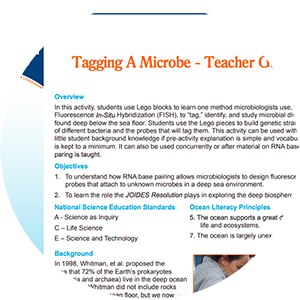Actvity Summary: Tag, identify, and study microbial diversity found deep below the sea floor.
An updated version of this lesson exists! Check out Deep Dive into Biodiversity Below the Seafloor!
In this activity, students use Lego blocks to learn one method microbiologists use, called Fluorescence In-Situ Hybridization (FISH), to “tag,” identify, and study microbial diversity found deep below the sea floor. Students use the Lego pieces to build genetic strands of different bacteria and the probes that will tag them. This activity can be used with very little student background knowledge if pre-activity explanation is simple and vocabulary is kept to a minimum. It can also be used concurrently or after material on RNA base paring is taught.
- Standard A: Unifying concepts and processes in science
- Standard B: Science as inquiry
- Standard D: Life science
- Standard E: Earth and space science
- Patterns
- Asking questions and defining problems
- Developing and using models
- Obtaining, evaluating, and communicating information
- LS2.C Ecosystem dynamics, functioning, and resilience
- LS3. B Variation of traits
- LS4.A Evidence of common ancestry and diversity
